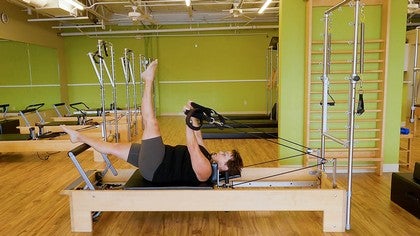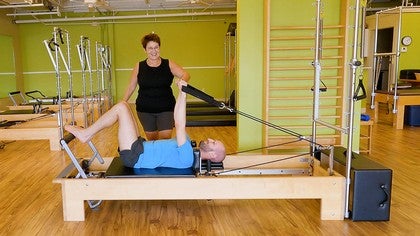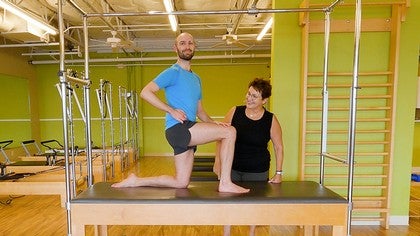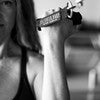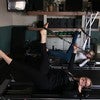Description
About This Video
Transcript
Read Full Transcript
Hi, I'm glad you're here with me in my studio. Pilates Unlimited in Dallas, Texas. Today's session is going to be a combination on the reformer and the tower. Doing very clean, concise exercises, making you feel and find, if you will, key connections throughout your body. We'll start in standing.
I have two yellow springs coming from the top. I'm gonna start with standing chest expansion to get my body lengthened up to the sky. And then inhale pull back, exhale release. (Karen inhales and exhales) Eight times. Here's three.
You're pushing your knuckles down as you work to pull your arms just to the sides of your thighs. You wanna feel grow up as you push the arms down, and we'll get two more here, and last one. Now we'll do it with one leg. So we'll pull the arms down, march one leg up and down. The goal is not to be wobbly.
The goal is to be okay with your wobbliness. As you work hip flexion, chest expansion arms with attention to the verticalness of your spine. We'll get three more here. Arms are getting a little bit of information. The standing leg is getting a little bit of information, and then last one, and then pause.
Continuing now with our sit to stand, the spine is still not moving here. I'm gonna tone up my tummy just a little bit. Not gripping my belly, not gripping my bottom, hanging onto the spring. So I'm gonna press down as I sit back and stand up. I release my arms and then I pull my arms.
As I do this very calculated squat, if you will, my shoulders do come over my knees a little bit, and the knees are over my toes. I want to feel my quadriceps. I'm doing this with the long box and a little box on top. You can certainly take the little box on top off, and get a deeper squat. I'll do three more.
And two more. I like using the handles because it lets me use my arms independently. Continuing now with one leg, I'm gonna tap a little bit forward. Take one of my legs behind me. I'm switching to one leg now.
I feel a little bit wobbly, and that's okay. So I'm going to bend. Kind of bow and hinge a little bit and then stand up. So now my arms aren't pushing down. They're just going down, kind of keeping me in balance.
Focusing here primarily on that standing leg that is bending and straightening. Two more. Nothing fancy, but certainly informative to the body. And then switch. Switch legs, other leg comes up, and then down and up, and you will notice as you do this, one leg is often a little happier, a little more cooperative than the other, and that's certainly fine.
The springs help, but they also challenge a little bit. And eventually, I hope to let go of the springs, maybe hands to the tower. And then of course, maybe no hands. And then take yourself down from there. Moving now, continuing on to the reformer, gets my heart rate going, gets my blood flow going, I'm on two greens and a red spring.
You can even see after three minutes, I have a little bit of breath challenge using my body, the full body. And now I'm coming to the reformer. I mean, I'm coming to lie down on the reformer. I'm gonna raise my headrest just a little bit. It let's me heavy my ribs down.
Starting on the reformer, I have two greens and a red spring. First thing I'm gonna do, is just get a feeling behind my legs. Not overworking the butt squeeze or the belly pull, but just continuing with this activity of the action of the legs. Even though my knees are straightening and bending, I'm pushing from the back of my thighs. I will continue this with one leg.
Push and then return. As I bend the knee, I crease at the hip. I'm not pushing back with a tucked butt, but I'm pushing with a strong lengthened leg. We'll get two more here. And then last one.
Switching legs, push out with both legs so I can get this lengthening without changing the shape of my spine, and then continue with the one leg. Now what about that leg that's doing the pushing? Can you feel like you're trying to push the foot bar all the way across the room? So you're not just straightening the knee, but you're pushing the body away from the closed spring. Sometimes I tell clients open the spring, and then close the spring.
Open the spring, and then close the spring. Last one. And then rest. Take your feet now for something different, lower them down to the wood, curl your toes over the edge of the wood, and from here, can you just press out enough that you feel the top of your ankle. That top of your ankle, feel the bird foot connection, but it's a broader feeling than when we take the feet up on the bar.
You may even feel a little cramp. You might feel a little extra work in all those lumbricals, those feet muscles. And now watch, go out, flex your ankles, push your legs, bend in, fold your feet back over the top, and then close. Do that three times. Keep the ankles lengthened.
Then when you can't stand it anymore, you'll pull your feet up. The belly stays toned, so the spine doesn't move. And then we come back. We'll do that one more time. And then return. Now we come back to our feet on the bar for that bird feet position.
And try to get your feet to curl over, and kind of press down on your feet as you go out and in 10 times. Here's the third one. Halfway done. Keep your legs active on the way out, meets your in, meets your out, meets your in, the challenge is to keep the connection. And three more.
And two more. And last one, and then rest. Two legs come all the way long on the bar. Flex your feet. Take an inhale, and as you exhale, lengthen through those same ankles, start to just lift yourself up a little bit and then down.
And then leave the headrest up for these first few. And then one more time. You're pressing down with your legs up with your bottom, but you're not punching up your spine. And then release. Now I'm gonna lower the headrest down, and I'm going to attempt to lift a higher long leg bridge.
Arms are pressing down, feet are pressing down. I'm gonna lift up, and then I'm gonna crease my hips, drop down, flex the feet. Inhale. Exhale, toes point, lift up, tighten thighs, arms press down. And then crease the hips.
One more time. It's like a lengthened bridge. Maybe I lift one leg, maybe I don't. Where are you today? You do what you can.
Bring yourself in. Now with the feet on the bar, we will articulate up. So that means you're going to tip your pelvis, and then lower down. Now the headrest stays down. Curl.
Now this curling thing and the hamstring thing, it's very interesting. We often cue not to move the carriage, and that's certainly fine and noble, but sometimes if you pull that carriage in too much, it does a hamstring curl instead of a glute lift. So I'm gonna say if the carriage moves a smidge, it's okay. And then come down. All right.
So now back to the feet pressing out, and then take your head, lift it, look towards your toes, and make sure your thighs are long. You put your throat down, you put your head down. I'm going to come back and raise my head just a little bit, it keeps my back ribs down. I'm gonna start the marching, one leg in. And then, and as I pull this bent knee in, this other leg is staying long and strong.
This is what we did in standing. Switch. Press the feet, right? Without locking down the knees, just press the leg long out from the abdomen, and then bend. Be mindful of your head position, meaning that the bridge of your nose pulls the back of your skull, and that is where the center of the back of your head is.
We'll do this two more times. And then last time. Now that exercise advances when you put your thighs in the straps facing the other direction and do knee flexion with spring. So now it would be parallel feet. Up and in.
So the first couple, I don't straighten my legs all the way, 'cause I'm trying to get loaded legs. Then when I really feel I have that, I tighten and then bend. So now I'm lingering in the out phase feeling where it is, because what I really wanna do is continually go. Out, meet your in, meet your out, meet in, and three. In, everything stays in place.
Not pausing in the out, not pausing in the in. Four and three and two and one, and run. Lift, down. Down, lift, down, lift. Lengthen, it's not a sache, it's a work.
Body pushes up towards the crown of my head. And five, four, three, two, and one. Bend the knees. Okay. Heels apart on the bar. Open your legs as wide as you can and then close 'em.
And then put 'em somewhere in the middle. So just press out and in. Common, very common feeling of attracting your heels together. But we're gonna challenge this and change it up a little bit. So you're gonna go out in external rotation, come in internal.
Go out in internal, come in and external. Like my hands really need to tell my legs what to do. I think that's funny. Sometimes in my hands, they do that when I teach others. And when I teach myself, I find it really interesting that I do the same thing.
Sometimes I even tell myself, "Good job," which I think is really important. One more time, we're working from the heels, taking turns internal and external. Now go to the balls of the feet, open your knees as wide as you can, close 'em, and then put 'em somewhere in between. So now I'm gonna go out in external. I'm gonna spin my heels.
Like you're on those little balanced discs. You know those little, you have the discs that teach those thighs internal and external without load. And then of course you have those loaded ones. We'll get three more in here. Just working on this hip.
Nice straight spine. Last one and rest. Okay, I'm gonna roll to my side, bring myself up to change my springs. So I'm changing to two red springs now. And I'm actually gonna straddle the carriage.
I know that sometimes we're not supposed to straddle the carriage, but sometimes when I have this low reformer, and I straddle the carriage, it helps me get my packages in order. Meaning that my ribs are back, my head package is back, my bridge of my nose is back. So we really feel this upright posture. And then from here now, I'm just gonna start to do a little spine twist, not anything too cray-cray, but just starting to get the idea of a twisting of my spine, because we know that in these more fundamental sessions, we have to get all the positions and motions of the spine. One more left and one more right.
And now I can take this arm and put it all the way back on my shoulder rest, and I can give myself some help, but I want you to be careful when you give yourself that help, because sometimes that can actually be a little dangerous. So you wanna get the movement first, and then ask for some help. Then you can go back and actually see if you got a little more motion. So again, I'm not telling you not to help yourself, but when you do help yourself, be sure you're spiraling right in this session of thorax, ribs. And then you give yourself a little check to see if that rotation actually did improve.
Now, lying on the back. Again, we have two red springs on. My headrest remains up. I'm gonna take my hands to start in the short straps. And then I'm going to start to load my arms over my shoulders.
I'm gonna make a fist around these straps. And then as I hold my arms to integrate my arms with my trunk, I'm gonna start this marching here again. Again, this isn't very challenging, but it's letting me tie my arms to my trunk. And then it'll get a little bit more challenging when I have both legs up and I go up and up. So now I get my quadriceps to help me straighten my knee.
And then I do quadriceps, ankle reach, point the toe, bend the knee. Quadriceps, ankle reach, point the toe, bend the knee. Now I do two. For three, two, and one. And now I add reach, heels, point.
Everything is just a progression. I don't mean just, but as long as I'm holding my torso here and my arms are integrated with my trunk, then maybe today I lower one leg to the foot bar, raise it up. My arms are keeping my trunk connected. Maybe today I lower two legs down and raise two legs up. Maybe I can do it again.
Or maybe not. It will be your call every day to see where you are. That's one of the good things about Pilates. It meets your body where it is on any given day. Now pull the arms.
Knees will come in simultaneously. Start arm circles. (exhales) And really, this arm circling business is another way to advance the connection and the integration, your arms with your trunk. How about if I continue the circles and sway my legs to the left? What have I done now?
Well, I've added a rotation challenge to my trunk. Come back to center. Legs sway to the other side. Add a circle. Two thighs are squeezing, right?
So I'm really trying to find this connection to be maintained as my legs sway, they come back to center, the arms come down. Now, there's another way to add great challenge here. I'm gonna switch to my long strap, and I know you might be thinking, "Gosh, where's the hundred beats?" Well, you know what? It's not gonna happen. I'm not flexing the spine yet, and I'll tell you why in a second.
So you have one arm. I use my legs to push away, to get my arm in the position I want it to be in. The reason why I make a fist, is I want to engage my wrist, my finger flexers, to help inform my whole arm. Now, two legs come up. Now, the thing is, this is a lot harder than it looks.
If somebody were to walk by, they'd say, "Whoa, that lady's not doing much there." Ooh, this is big load. Two red springs held with one arm, move the legs. Five, six, seven, eight, nine, ten, and rest. I think I started with five instead of one, but that's okay. We're just doing enough.
We're gonna do that again. So pull the arms. Scoop in your tummy. Not gripping it, right? Just enough to give a little tone so that when you lift your legs, your spine doesn't change shape.
We're gonna hold this right here. And then the arms will go out and in. I'm trying wicked hard not to move that carriage. It may be moving a little bit, and I got two more. And last one, and rest down.
Whew. Other arm. So I've switched to the longer strap, because this is a little too heavy way back there. So now I have my left arm in. Use my feet and I'm getting connected here. Two legs come up.
Oh, this is my left arm. This is a little bit challenging. So I'm gonna try not to lurch my body to one side or another. I'm trying to hold my sagital plane alignment with this one-armed rotational force, if you will, holding it right there, and then add the legs. And legs.
And you know what? Even though I'm moving my legs, you can hold one of your legs. You can hold both of your legs. You can circle both of your legs, like a cork screw. If you understand the concept, you can then challenge it. That is really a good exercise.
Now, before I put my legs in the straps, my hands will come back to the pegs, and then I'm going to pull up on my arms as if they're going that way. And what that lets me do, it lets me connect through my ribs here. Then I can pull my knees closely in, continue with the hip flexion as my butt lifts a tad. Pull, and then a tad. So now this is trunk flexion from the bottom using my hip flexion to pull in, and then my pelvic tilting to use my abdominals to curl.
That starts to get that little load in the bottom. I like to use my hands on the pegs because it helps me a little bit. Is that cheating? Sure. But it's informative.
Okay? So don't get caught up thinking that you somehow have to all of a sudden do something perfect, if you've never thought about it in a different way. So here's your traditional circles here. Right? That T-shirt, that says, "I'm here for feed and straps." Now, as you do these circles, I want you to pay special attention now to where you feel the biggest load in the circles.
I feel my biggest load right here. Yours might be in a different place. And so now I'm gonna try to speed up my circles. Even though I'm pulling the springs, I'm gonna try to keep this load in all around my thighs. Three more.
Two more, check in with your head position. Last one and then bend the knees and rest. When you bend the knees, the knee deep flexion allows your trunk to curl. You can hang on here for a second, and curl up a couple times. Go out, find that load again, where your circles are.
I mean, let your legs- go ahead and turn 'em way out. Go ahead and turn 'em way in, and then find some spot in the middle where you can kind of feel load all around the circumference of your leg. And now we're gonna reverse the direction of the circle. So you're going a little bit quicker to get little bit of buildup so that the carriage isn't really stopping- Oh, there I go with my hands again, or lingering. Woo. And then bend your knees all the way in.
It's just a different feeling. Hands on my pegs, my belly scoops. Now, this is a different kind of work here. This is me finding flexion for a feeling. Now the thighs will come to vertical.
Heels will be together. So my thighs are roughly at a right angle. Right? You can see that, right? So thighs at a right angle, shins at a right angle. Now, I'm going to try to curl my pelvis without bringing my thighs in.
So this is hard. So I'm gonna deepen my belly and press my arms down, 'cause that helps. And I'm gonna try to curl. So what happens now, it becomes a little bit harder because I'm not allowing my thighs to come in to give me this momentum. So I'm gonna hold the legs deep in the belly, and add just a little bit of push.
I mean a little bit of pull in with the tummy to reach out. I'm gonna put my hands on the pegs again. So I'm trying to get this initiation of the curl without the thighs. And I'll go straight legs. I'm not going to do short spine.
I don't want you to be on the reformer and turn your head to the side, but I am gonna go back enough. I don't particularly have tight hamstrings, but I'm gonna go back enough that I feel the deepness in my hip crease. And I feel like I call it like a little diaper change, like a little baby's diaper change, a little curl. And just a little curl. Then I'm gonna stop my legs in vertical. Right?
So my legs are roughly vertical here, and now I'm gonna try to push my legs, which way? To the ceiling. To the ceiling, there we go. So now, and ideally, this is really how we wanna start short spine. I need a little bit more spring to do short spine.
Sometimes the heavier the body, you need a little spring to help you have the giddy up. So don't ever be afraid if you're, you know, over 1.60, 1.70, to add an extra spring for rollover. I mean for roll over and for short spine. Woo. So all I'm doing there, is trying to get the initiation. Alrighty.
So now, take the straps away and hang 'em up. And now we'll turn around and we'll face the other direction. Put the headrest down. So now we will work the spine inflection now going backwards. Okay? So again, we have these two springs on.
I'm gonna take my straps here. I'm gonna actually choke up and I'm gonna hang onto the thickness of both the straps like this, because I like the way that starts to feel information in my arms. So from here now, I don't wanna pull my arms around my shoulders, but I wanna hang onto the straps, and just curl my pelvis as I lower my low back down. And then I come up. I'm not gonna talk through this a whole lot, 'cause it's hard.
So my belly pulling back is what's moving my body back. I'm not pulling with the straps, but I'm hanging on to the straps. It's kinda the way short box should feel. But sometimes that's a challenge, because in short box, your feet are over the edge of the box and your hips are not flexed. With your hips flexed here, one leg, other.
What shape does this look like? Rolling like a ball, right? And then bring yourself all the way up. One more time, adding a little bit of rotation. Inhale, exhale.
Really get the rolling back of your pelvis. So you're not rounding the trunk forward. Your trunk is flexing. You are making a flexion connection, and now pull right arm, look to the right here and center. Pull with left arm, center.
One more time. And then one more time. And then come up. And then hang up the straps. Continuing on the knees.
So kneeling is halfway to standing. And I'm gonna take one red spring off. So now I have one red spring total. So I'm just gonna pull the arms back. It's not heavy to start with.
As I pull back, I'm just gonna turn my head to one side, and leave it there. I'm not pulling my arms way far behind me. I'm reaching down and keeping them engaged. Now I'm gonna travel my head to the other side, and then release and pull. Notice how small the pull is.
Because sometimes when the pull gets too far behind us, it makes us arch the back and change the package of the ribs. No package changing of the ribs during that pull, unless, of course, we are gonna go into extension. So now I'm going to do this with one arm. So I'm gonna keep hanging onto both straps, but I'm just gonna pull with the right. And then as I hold that right arm, I'm gonna twist my trunk to the right, and pull the arm a little bit more.
And now I have my left knee, left butt, really working. And then I'm gonna unwind it to the pelvis, right? Then the arm, then the rib cage, then the head. Let's do that same side again. I'd like to do three in a row.
So I'm just really using my right arm here. Hold, twist. Head, thorax. That strength of your arm and your left butt, and then come back to center. Woo. And then last one.
Arm pulls. We twist, we rotate without lurching or leaning, and then come back to center. And then other side. Left arm, this is one red spring. I add- oops, I got ahead of myself with my pelvis, and I need to pull the arm, and I need to turn that thorax.
And then I need to find that right butt. Hold. And then I unwind, and then center. That's one, we're doing three. So don't get ahead of yourself. Be patient right?
Patience, part of our practice. Here's the third one. Last one. Gather up your shins down, gather up the tone in your belly, arm pulls you, hold. Trunk twisting.
Trunk twisting, you hold, and then release all the way back. So what is practice? Well, practice means that we do a behavior over and over again until it gets better. So if we want to get better at anything, we need to practice, and we need to be consistent in our practice. And now, we have to do spinal extension.
We're almost done. So I'm going to go ahead and leave it on one red spring. So more isn't necessarily better, right? But we wanna keep these connections. I'm obviously working through my body.
I feel heat in my system, et cetera. And here you go down. I'm talking in between to give you a rest too. Hopefully you're joining me with this. So first, without even grabbing the straps, find where you can be on the box so that you're not lifted to start with.
So my arms aren't behind my back. My head is in line with my spine. I should feel my buttocks and my thighs. Now, if you can be here, and the box is kind of bussom halfway. So if I got further forward, and I looked- see my feet down here at this bar here?
I'm just gonna keep them there. And I'm gonna flex my trunk forward. And what that's gonna do, it's gonna kinda lengthen this thorical lumbar area. And then as I let go of my feet and keep them active, I'm gonna ask myself, I'm gonna say, "Self, can you just come up to what you believe is level?" Because sometimes level is just good enough to keep that relationship going in the back body. Down, and then level.
Now, what about if I wanna go up? Do I move my arms? Or do I lift my chest? And then recognize level. And then lower down.
A lot of times, people wanna just rest here and, you know, turn to the side and then just resting their arms, which is fine as a rest, but recognize that sometimes the work is in the holding. So I'm gonna move myself back a little bit to give myself a little more box space, and then I'm gonna squeeze my straps. Only pulling my arms to about 90 degrees. Just stop right there. Now I'm gonna start the exercise here.
I'm already loaded. And then I'm gonna be patient with the pull. And then I'm be patient with the lift, and not over pull. And then everything will come down to 90 degrees. Hold the load.
Patient with the pull. Add the lift. Release the lift, release the pull, hold at 90. Last one. Hold, patience with the pull, lift and hold.
And then everything comes down and rest. All right. So spinal extension. The last exercise to do here in standing is keeping the box on. It's much like how we started there using the springs and stuff, but we're just gonna take one leg all the way up on the box.
Watch. (Karen groans) That's pretty high. Even though I feel like I'm six two, because it really matters how you feel. So now, I'm at the end. Some dynamics, I'm gonna lift this leg up.
I'm gonna put it on top of the box. And then I'm gonna come forward, relaxing my shoulders. Good. And now, your hands are gonna come all the way to the ceiling. And I'm gonna get my leg up on the box, trying really hard not to bring it out to the side.
Up. Reach up, lift the leg up, touch. Ooh, I feel which leg is better. We do 10 of these. Three, four.
How high can you reach your arms? Five. I can't count. Six, seven. I think this is right. Eight and nine and 10.
And relax your arms. Arms on the top of the box. Bend your knees a little bit, and let your head come down. Now left arm, right arm. These are your upper trap.
These are your Is, right? This is capital I. This would be a Y, and this would be a T, right? Sometimes we do those exercises over a ball. I mean over a ball, but today we're just doing them here.
And then I can lean my body back, and I can really do them without sagging. I'm in a hip hinge, and then I'm gonna go one, two, three, four, five, six, seven, and eight, two hands come down. Push the hands down, pull the front ribs to the back ribs, and rest. Thank you so much for joining me on this reformer tower session.
Key Connections: Find your 'A-Ha' Moment
Comments
You need to be a subscriber to post a comment.
Please Log In or Create an Account to start your free trial.
